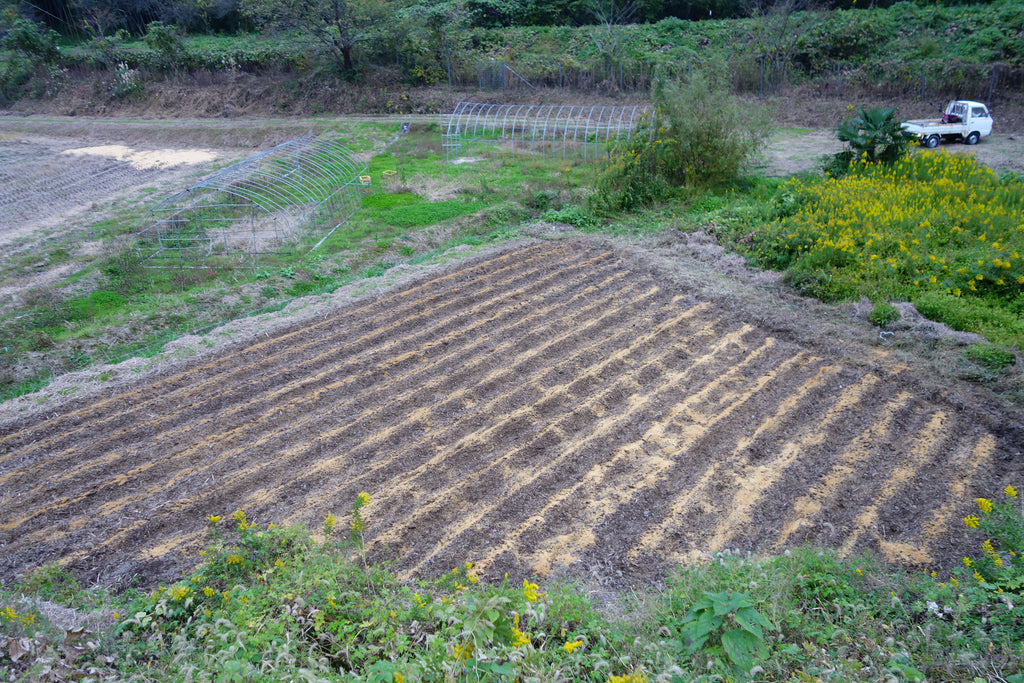昨年の秋、大多喜町の山間に小さな畑を借りました。

元々は田んぼだった土地が使われなくなって、区画整理した後に貸し出した農地。の、さら借り手のつかない端のわずか一辺15mほどのしかも三角の土地。農機の取り回しもしづらいため、十数年以上何も使っていなかったそうです。
だからこそ初めての私たちにはちょうどいいと思いました。
土地の持ち主の野口さん、そしてmitosayaの自然生活の先生、AMBESSAの君島さんと共に、ライ麦の栽培を行います。
mitosaya三角畑と名付けたこの土地。まずは土を掘り起こし、畑にします。

長年使われていなかった土地は雑草だらけで、いかにも硬くて、さらに粘土質。
手押しの耕運機で耕していくも、すぐに顔を出す葛の根、耕運機にまとわりつく泥土の固まりがなかなか進ませてくれません。
難儀しつつも2回耕します。(ちなみにこの辺りの人は耕すことを「うなる」っていいますが、これは方言?専門用語?)

つぎは畝立て。こちらも手押しの畝立て機を使って耕しながら畝をつくります。高さ20cmほど、山の平たい部分が30cmほどの畝を作っていきます。
水はけをよくするためにクワでさらに溝を深くして完成。
畑っぽくなってきましたが、まだまだこれから。
次は山の真ん中に棒を引きずって、麦をまく溝を掘ってからようやく麦まき。
片手で握り持って親指と人差し指の腹の間から、均等になるようにまく。密でも疎でも育ちが悪くなると言われるも、これが難しい。
大人が3人、ほぼ1日かかってようやく麦をまけました。
2週間ほどするとうっすらと麦をまいたところに芽がでてきます。

どんどん伸びてくる麦が土を持ち上げてしまうのを抑えるために、伸びてきた麦を踏むのも冬にやること。
何度か雑草取りをしながら大きくなるのを見守ります。

GWの頃には、子どもの背丈ほどに大きく伸びてきます。

同時に穂がついてきますが、最初の頃は、穂の中は白い液状のものだけ。
徐々に穂の中に実がついてくる。背丈が伸び、穂が大きくなるにつれて、茎も穂も茶色になってきて、穂は重くなり、頭を垂れてきたら、いよいよ麦刈りのタイミング。

6月の終わりにまた3人で集まって麦刈り。ここでも手押しの刈取機が大活躍。借り倒したものを手で集めて紐でくくり、軒下に作った干場で乾燥させます。これをこのあたりでは「おだ掛け」といいます。

本来なら2週間ほど乾燥させたいところですが、梅雨真っ最中の今は湿度も高く、雨に当たると芽が出てきてしまうので、君島さんの判断で2日でおだ掛けは終了。ハーベスターで脱穀します。

もみと麦わらに分け、もみは梅雨明けに天日でかっちり乾燥させることにします。収穫量は約25キロ。初めてにしては上出来な粒の大きなライ麦です。
天日で干しては、夕方には取り込むということを何度か繰り返した後に保管。
次の麦蒔きに備えます。

一方、麦わらはいよいよストローに。ガレージ一台分ほどの量の麦わらを、南房総の知的障害者授産施設、中里ワークホームの皆さんに協力いただいて、麦わらのいい部分を指定の長さにカットしてもらいます。
数カ月後、きれいにカットされた麦わらが届きました。

これを煮沸消毒後、乾燥機でしっかり乾燥させます。その後、検品をしてライ麦のストローの完成です。
一粒のライ麦を土にまいてから約一年。自然素材のため太さにばらつきがありますが、きれいなつやと適度なハリのある約2万本のストローができました。
麦のストローなので、Straw Strawと名前をつけました。一生懸命新しいものを作ったつもりが、元を正せばもともとのストローそのものを作っていたわけで、無知というのもものづくりの素晴らしい原動力だと改めて思った次第。
本数やパッケージ、あとは価格。そのあたりにも喧々諤々があったのですが、長くなるので省略。こんな形になりました。

また新しい一年が始まります。
今年は新しく広い土地を借りることが出来ました。
1反(300坪)ほどの長方形の土地。この土地にも先日麦をまきました。
もちろん、mitosaya三角畑にも。
いつかこのライ麦がウィスキーになるまで、気長にお付き合いください。

Last fall, We rented a small field in the mountains of Otaki Town.

The land was originally a rice field, but it was no longer in use, and we rented it out after the land was rezoned. It was a triangular piece of land with only about 15 meters on each side. It had not been used for anything for more than ten years because it was difficult to maneuver farm machinery.
That's why we thought it would be perfect for our first time.
Together with Mr. Noguchi, the owner of the land, and Mr. Kimishima of AMBESSA, mitosaya's natural life teacher, we will be growing rye.
We named this land "mitosaya triangle field. First, we dig up the soil and turn it into a field.

The land, which has not been used for many years, is covered with weeds and is very hard and clayey.
We started plowing with a hand-pushed tiller, but the kuzu roots that soon appeared and the clumps of muddy soil that clung to the tiller made it difficult to proceed.
We plowed twice with difficulty.

The next step is to make ridges. The height of the ridges is about 20cm and the flat part of the mountain is about 30cm.
To improve drainage, we used a hoe to make the furrows even deeper.
It's starting to look like a field, but there's more to come.
Next, we dragged a stick to the middle of the mountain and dug a trench for sowing wheat.
Holding the sticks in one hand, sow the wheat evenly between your thumb and forefinger. It is said that neither dense nor sparse sowing will result in poor growth, but this is difficult.
It took three adults almost a day to finally sow the wheat.
After a couple of weeks, the wheat sprouted slightly where we had sown it.

Stepping on the growing wheat is another thing we do in winter to keep it from lifting the soil.
We watch them grow while we weed them several times.
By the time mid May comes around, they will have grown as tall as a child.

At the same time, ears start to appear, but in the beginning, there is only a white liquid inside the ear.

Gradually, the ears begin to bear fruit. As they grow taller and the ears get bigger, the stalks and ears turn brown, and the ears get heavier, and when they start to hang their heads, it's time to harvest the wheat.

At the end of June, the three of us gathered again to harvest the wheat. Again, the hand-pushed reaper was very active. We gather up the fallen barley by hand, tie it up with string, and dry it in a drying area under the eaves. This is called "oda-gake" in this area.

Normally, we would like to let them dry for about two weeks, but it is very humid in the middle of the rainy season, and if they are exposed to rain, sprouts will appear, so Mr. Kimishima decided to end the drying after two days. We will thresh them with a harvester.

The fir will be dried in the sun after the rainy season. The harvest was about 25 kilograms. It's a good crop for the first time, with large grains of rye.
After drying them in the sun and taking them in in the evening, we stored them.
It is now ready for the next sowing of wheat.

On the other hand, the straw is finally made into ”straw”. With the help of the people at the Nakazato Work Home, a vocational facility for the mentally handicapped in Minamiboso, we cut the best parts of the straw to the specified length.
A few months later, we received the neatly cut straw.

After boiling and disinfecting it, we dry it thoroughly in a dryer. After that, the straw is inspected and the rye straw is ready.
It takes about a year from the time a single grain of rye is sown into the soil. Because it is a natural material, the thickness of the straws varies, but we were able to produce about 20,000 straws with a beautiful luster and moderate elasticity.
We named the straws "Straw Straw" because they are made of wheat. I thought I was trying my best to create something new, but to be honest, I was creating the original straw itself, which reminded me once again that ignorance is a wonderful driving force in manufacturing.
The number of straws, the packaging, and the price. We had a lot of arguments about that, but it's a long story. This is how it turned out.

Another new year is about to begin.
This year, we were able to rent a large plot of land.
It's a rectangular piece of land about one hectare in size. We sowed wheat on this land the other day.
Of course, we also sowed wheat in the mitosaya triangular field.
Please be patient with us until this rye turns into whiskey one day.




